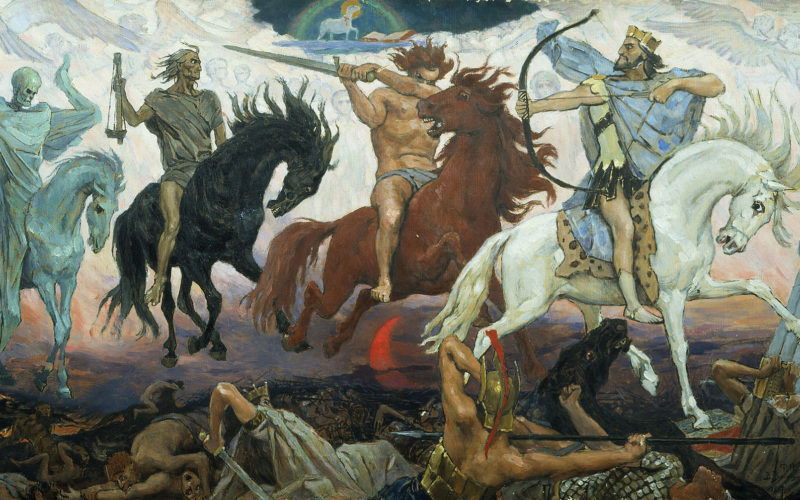With world-wide protests raging in the aftermath of the murder of George Floyd at the hands of police, the reality of inequality in the developed world is suddenly front and center.
This is happening in the midst of a pandemic and follows shortly after unprecedented weather events including massive bushfires in Australia.
I am reminded of the story of the four horsemen of the apocalypse which is drawn from the New Testament. The third horseman, representing oppression, rides a black horse and holds the scales of justice. Currently, we are in the midst of a pestilence – represented by the first horseman. And the ongoing War against climate change continues – the second horseman.
That leaves the fourth horseman – do you really want to know? – he represents death. We’re not there yet, so let’s back up.
We have faced three challenges in quick order –climate change symptoms, a pandemic wave and the public exposing of inequality. In an earlier post, There is no Vaccine for Climate Change, I compared the pandemic response with the fight against climate change.
On this occasion I want to look at the plight of Black America and compare it with the battle against climate change. In many ways the parallels are closer than between climate change and the Covid-19 pandemic. Here’s why.
The first slaves were transported to America in the 1600s, and the slave trade grew significantly in the 1700s as agricultural and industrial production expanded. By the start of the Civil War in 1861, there were nearly four million slaves in America, representing 14% of the population. After the Union victory in the war, the US Congress passed the 13th Amendment in 1865 which abolished slavery. All remaining slaves became technically free. The 14th Amendment granted citizenship and the 15th Amendment the right to vote.
Despite the so-called ‘Reconstruction’ after the war, new techniques were developed to suppress the black population. For example, under ‘convict leasing programs’, African-American men, often guilty of no crime at all, were arrested, and compelled to work without pay. Sharecropping, another technique, often involved severe restrictions on the freedom of movement of sharecroppers, who could be whipped for leaving the plantation. Both sharecropping and convict leasing were legal and tolerated by both the north and south. ‘Jim Crow’ laws which mandated racial segregation were widely legislated in the southern states, and measures were put in place to make it very difficult for black people to vote.
It was more than one hundred years after the Civil War, that the Unites States passed the historic Civil Rights Act in 1968. You would have thought things must have improved in the fifty years since then for the African-American community? Think again. Suppression practices have been entrenched in the American psyche for more than two hundred years. Cultural inertia is notoriously slow to shift. Even today there is tolerance of the shocking wealth gap between blacks and whites in America as demonstrated in the graph.

It was the civil rights movement in the 1960s that led to the Civil Rights Act – a significant breakthrough. In the intervening period there have been many black deaths at the hands of police, and there have been race riots in various cities, but we have not seen an apparent coming together at a national level of the scale of the reaction to George Floyd’s murder.
Lets compare that with the journey on climate change. Growing recognition of the dangers of climate change led to the United Nations Framework Convention on Climate Change in 1992, a treaty which sought to “stabilize greenhouse gas concentrations in the atmosphere at a level that would prevent dangerous anthropogenic interference with the climate system”.
Nearly thirty years later and greenhouse gas concentrations have yet to stabilize. Are we just too wedded to our current lifestyles, and reliant on plentiful and low-cost fossil fuels? With the mantra of ‘growth’ and ‘progress’, the global community has found it difficult to change direction.

We have had plenty of ‘skirmishes’ – heat waves in Europe, diminishing water supplies, thawing permafrost, unprecedented wild fires, retreating arctic ice, bleaching coral reefs. But they have not reached a point to sway our collective consciousness for sustained global action. Just as in America, it is more comfortable to just tinker with the status quo. Most of our political leaders don’t want to rock the boat with dramatic climate change initiatives.
When and what will be climate change’s tipping point where the forces of climate change will stare us in the face and be undeniable? Maybe it will be an ice sheet collapse, or maybe the dislocation of a long term ocean circulation that turns the weather upside down. And then, will there be enough time for us to act and prevent the worst of the consequences, or will it be too late?
The reforms to combat inequality will take a long time to develop, to implement and to reap the benefits. We are talking decades. So too will be the climate initiatives that are required to avoid the worst consequences of climate change. Ironically, one of those consequences is the further accentuation of inequalities in our societies.
So let’s keep working on emissions reductions, on reforestation, on sustainable living. Let’s accelerate these initiatives now without waiting for climate change’s tipping point. Like the pandemic – let’s flatten the curve now. Let’s keep the fourth horseman well away.
Image Credit: Viktor Vasnetsov, The Four Horsemen of the Apocalypse, 1887
